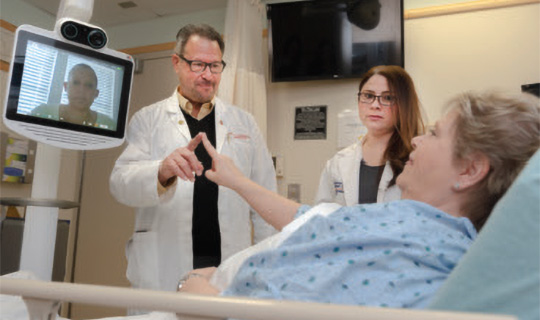Patients Are Evaluated And Treated Quickly With The Help Of Technology.

Every year, more than 795,000 people have a stroke, in which a blood vessel that delivers oxygen to the brain is blocked by a clot or ruptures, causing bleeding. As a result, brain cells die or are damaged. In 2018, Community Medical Center (CMC) treated about 700 stroke patients. CMC is a Primary Stroke Center, an advanced certification given by The Joint Commission, a not-for-profit organization that accredits and certifies health care organizations. The designation indicates that the hospital complies with clinical practice guidelines and performance measures for stroke care.
Time is of the essence when it comes to treatment. For an acute ischemic stroke, in which a blood clot blocks an artery, a clot-dissolving drug called tissue plasminogen activator (tPA) must be given to patients within three hours (for certain patients, up to 4.5 hours) from the time symptoms begin. In some cases, this type of stroke is treated with a device inserted into a blocked artery to break up a blood clot; this can be done up to 24 hours after symptoms start. A hemorrhagic stroke, in which a clot ruptures, can be treated with minimally invasive surgery.
Delivering The Best Care
Stroke care at CMC begins when a patient calls 911. “The patient is evaluated over the phone and fast-tracked when he or she arrives at the hospital,” says Lindsey M. Smith, BSN, RN, SCRN, Stroke Program Coordinator. “The local emergency medical services (EMS) team notifies us that a stroke patient is on his or her way. After the patient arrives, the EMS and Stroke Team take him or her for an immediate CT scan. Then the patient is brought to the cardiac trauma area in the Emergency Department (ED), and an assessment takes place.” At CMC, continuing education and training enable health care professionals to deliver the best care. The hospital provides neuroscience seminars for nurses four times per year, and nurses in training learn how to assess stroke patients. Since stroke care begins in the field, CMC also educates its EMS partners. The EMS teams receive stroke education twice a year. This is important because treatment guidelines change (in fact, they were updated just last year).
A Video Exam
In April, Community Medical Center launched a “telestroke” program, in which a neurologist in another location evaluates patients in the Emergency Department (ED) through a video screen. After the EMS team notifies the ED that a patient with signs of stroke is on the way to the hospital, a nurse activates the telestroke program. A neurologist appears on the video screen and evaluates the patient in 10 minutes. The screen magnifies the patient’s face, including his or her eye movements, pupil size, tongue movements and ability to speak. Imaging tests are taken, such as magnetic resonance imaging (MRI) or CT scan. With the twoway screen, the neurologist can check the results of imaging tests. “The system is working well,” says Gerald J. Ferencz, MD, Medical Director of the Primary Stroke Center. “It helps us to create a care plan, which improves patient outcomes.”
To learn more about the Primary Stroke Center at Community Medical Center, visit our website.